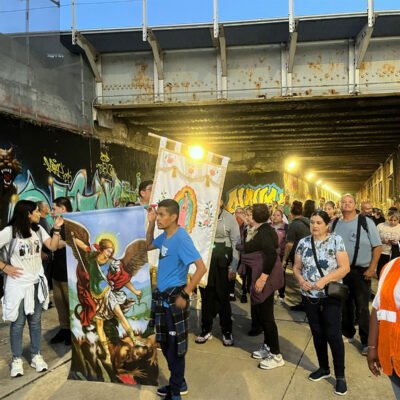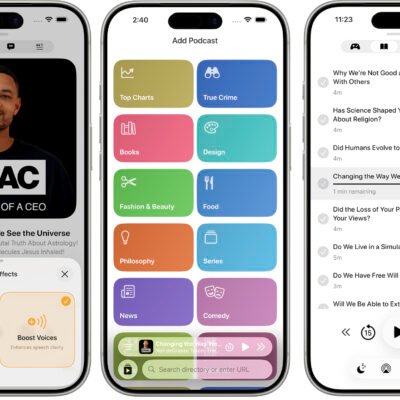George Hawkins, a 2019 graduate of TAH’s Master of Arts with a Specialization in Teaching American History and Government (MASTAHG) program, was named South Dakota Teacher of the Year in October. Administered by the Council of Chief State School officers, this prestigious award program honors one teacher from every state and territory of the US. Hawkins was selected as “the best of the best” from a pool of nominees working in every subject area and grade level in South Dakota. Yet Hawkins himself attributes his effectiveness to the alternative school program in which he works. The program requires creative collaboration among colleagues who are specialists in different subject areas. Hawkins sees teaching as team effort to that helps young people work and learn cooperatively..
Hawkins has worked for 12 years in the New Tech Network of schools and academies. Established in 1996, this national nonprofit helps schools and school districts implement project-based learning, in which students acquire academic knowledge while completing projects that put that knowledge to work. In addition to making learning more “experiential,” the New Tech model inculcates the “soft skills” young people need to succeed in the increasingly innovative and team-based work environment created by the digital revolution.
Hawkins’ Discovery of the New Tech Approach
When Hawkins first set out to teach, he was unaware of this teaching approach. He did his student teaching in a traditional classroom. Trying to meet the curricular standards for history and government while teaching students who showed little interest in those subjects frustrated him. “I concluded teaching was not for me,” he recalled. Instead, he went to law school, graduating as the 2008 housing crisis threw the economy into recession. “I hung out a shingle and took whatever cases I could get. I got a lot of court-appointed public defender cases, many of them filed for abuse and neglect.” Such cases were even more “soul-sapping” than the rigidities of the traditional education system. Learning of a Social Studies opening in an intriguing, “alternative” public high school, Hawkins considered giving teaching another go.
As he sat in the principal’s office of Sioux Falls’ two-year-old New Tech High School, waiting to be interviewed, a student walked up to him and introduced herself. “She shook my hand, looked me in the eye and said, ‘How are you doing? My name is Susan. What’s your name? May I help you with anything?’ The student was a sophomore. I thought, ‘Where am I? At what other high school in America do sophomores introduce themselves to randomly visiting adults, offering to help them?”
Hawkins came to understand that “at New Tech schools, students interact with each other constantly, engaging in tough conversations as they work cooperatively on projects. They also meet frequently with adults—community partners who are invited to class to share their knowledge and advice. They quickly learn the ‘soft skills’ involved in interpersonal communication.”
Joining the New Tech teaching staff as it began its third year of operation, Hawkins helped the school build out its junior-level program. He stayed there nine years, until the program was renamed the Project Based Learning (PBL) Academy and absorbed as a curricular track at the new Jefferson High School in Sioux Falls. This solved a problem many New Tech schools face: students who attend them often leave behind extra-curricular options such as band, choir, and sports offered at larger, traditional schools. At Jefferson High, students in the PBL Academy can participate in extracurriculars without leaving campus.
Interdisciplinary Learning
Hawkins works closely with a teaching partner who specializes in English Language Arts. Project-based learning lends itself to an interdisciplinary approach. Hawkins shares most of his instruction responsibilities with his teaching partner. They work cooperatively in a large space created by merging two collapsible-walled rooms. He and his partner instruct two classes of juniors, each class lasting for two periods. “Some days my partner takes the lead, other days I take the lead; some days we lead as a team.”
Hawkins says the interdisciplinary, project-based learning approach allows him to “tap into students’ interests and aptitudes while at the same time teaching my particular content area. I’m super passionate about social studies, but many of my students are not. They may be more interested in art, science, or math. We just finished an activity that tapped into the math focus of some students. While studying the Gilded Age, we had them take on roles as oil barons.” Students bought and sold oil, using a fictional currency that Hawkins himself invented for use in various classroom projects.
In the New Tech model, “content doesn’t exist in silos,” Hawkins says. “Early on, the teaching staff at New Tech decided that every course in the program should incorporate literacy tasks. Working with a teaching partner who specializes in English, that’s easy to do.” But numeracy also needs reinforcement. Teachers in the PBL Academy take responsibility as a whole for the core competencies that state testing tracks. “Those English and math scores are a reflection on all of us,” Hawkins says. Moreover, any realistic account of history covers economic and financial factors.
Soon after he began working at New Tech, a student’s question pushed Hawkins to wonder how to integrate math with social studies. “While studying the Civil War, we put students in the role of travel agents and asked them to design tours of historical sites related to the war. Then we staged a “Travel-Con” expo in which each team prepared an exhibit showing the tour stops, what travelers would experience, and why these sites were important. A student commented, ‘In the real world, I wouldn’t just be assigned a convention space; I could ask for the part of the room I wanted, couldn’t I?’ In fact, anyone organizing a convention would charge for a prime spot,” Hawkins reflected. “I wondered how we might do that in class. I decided to invent a classroom currency and economic system. It has grown ever since.”
Integrating Math Helps Hawkins Integrate Social Skills
Each project period lasts for three to four weeks. Midway in a project, Hawkins holds an auction in which students bid on project options. Students pay for options that simplify or enhance their project work, using “money” they have “earned” in the course of other projects. For example, as they study the 1920s, they invest in fictive versions of Coca Cola, US Steel, and other enterprises, watching stock prices rise and calculating the best moment to cash in on their stock and withdraw bank deposits. Those who miscalculate, losing their savings when the market crashes, are forced into project parameters demanding greater inventiveness.
For example, as students study the mid-20th century Civil Rights era, they develop model city parks commemorating civil rights activists. Hawkins encourages them to look beyond heroes like Martin Luther King, Jr. and investigate activists for other causes, like feminism, the American Indian Movement, immigrants’ rights, and so on. After researching their ideas, teams bid on 1′ x 1′ project boards Hawkins and his teaching partner prepare. Some have streams or other land features. Some are connected to other teams’ boards, so that completing the project entails coordinating with those teams. Students also bid on options such as the right to add a written explanation to the project board; lacking funds for that, they will need to design features that reveal the memorial’s meaning without words. They may bid on the right to use first person pronouns when they present the finished project. Without this right, they “must talk about their team members’ work instead of their own”—which pushes them to work and learn cooperatively.
Why Hawkins Enrolled in MASTAHG
Hawkins was awarded a James Madison fellowship in 2015. While participating in an effort to revise the South Dakota State Social Studies Standards, Hawkins met a Madison fellow who suggested he investigate Ashland University’s Master’s program. The program is designed to deepen teachers’ content knowledge while accommodating their teaching schedules. Enrolling, Hawkins found it “an amazing program.” What he learned in one course overlapped with what he learned in the next, deepening and broadening his knowledge. New discoveries proved immediately useful: “Many times after an online evening class, I’d put what we discussed into the next day’s teaching,” Hawkins said.
The program increased his “comfort level” with the primary documents he taught. “As a teacher, you feel that you have to know it all. But sometimes you just don’t. So you gloss over concepts—you mention them, but quickly move on.” MAHG seminars, in which teachers work and learn cooperatively, “cause teachers to pause over the documents they teach, thinking them through. I saw connections I’d never seen before that I could now show to students. Learning occurs when we make those connections. If all we learn are isolated facts, we’re doing little more than getting ready for Jeopardy.”
While earning his Master’s degree, Hawkins taught a project-based government course. “My partner and I assigned a Federalist/Antifederalist debate,” Hawkins said. Students prepared for the debate by reading Federalist and Antifederalist essays Hawkins had been studying in the Masters program. Hawkins felt confident as he pushed students to make connections between the arguments made during the ratification period and the arguments over constitutional government that occur today. He had already thought through those connections with his fellow teachers in the Master’s program.
Confidant that he can steer students through the complicated intellectual terrain of American political thought, Hawkins helps students gain their own intellectual independence. Hawkins sees the effectiveness of his Master’s degree—and of the New Tech teaching approach—as he watches students’ confidence grow over the course of their junior year. “Students begin the year with tons of questions. ‘Where’s this? How do I do this? Tell me this.’ They bring a checklist of the reassurances they need. But we steadily push them to take ownership of what they’re doing. By the end of the year, when we walk around among the project teams to see how they are progressing, students say, ‘We’ve got this, Mr. Hawkins. We’re good.’”
Summarizing his teaching goals, Hawkins says, “I want my students to become critical thinkers who are willing to ask questions. I can never give them all the information they need to know; I can’t make every concept instantly clear. I hope they learn to make note of what they read and hear, and then to process that with a critical eye. If they learn to ask, ‘What is this author or speaker trying to tell me?’ and ‘What do I think about it?’—that will take them miles.”



